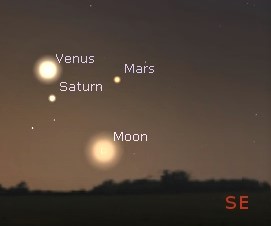This Week’s Sky at a Glance, 2022 March 26 – April 2
~by Curt Nason
For stargazers, early spring means it is time for a Messier Marathon. In 1758 a French comet hunter, Charles Messier, started compiling a catalogue of nebulous objects in the sky that resembled comets but weren’t. His completed catalogue was issued 13 years later with 103 objects. In the mid-20th century the catalogue was expanded to 110 based on Messier’s notes. Under a clear, dark sky all of the Messier objects can be seen in a small telescope, and it is a rite of passage for amateur astronomers to locate and observe them all.
The Messier catalogue includes 57 star clusters, 40 galaxies, 12 nebulae of new or dying stars, and an enigmatic pair of stars. The first on the list, called M1, is the Crab Nebula, the gaseous remnant of a supernova that was seen in daylight in 1054. M110 is a galaxy seen near M31, the Andromeda galaxy. The easiest to see is M45, the star cluster also known as the Pleiades or Seven Sisters. The Orion Nebula, a stellar nursery in Orion’s sword, is M42, with the much less spectacular M43 nearby. Many of the galaxies are within the area bordered by Leo, Virgo and Ursa Major.
For a few weeks in March and April, around the time of a new Moon, it is possible to see all the Messier objects in one night, hence the Messier Marathon. However, from New Brunswick the globular cluster M30 in Capricornus rises in bright twilight and is pretty much impossible to see at this time of year. That hasn’t kept some stellar stalwarts from trying.
This Week in the Solar System
Saturday’s sunrise in Moncton is at 7:10 am and sunset will occur at 7:39 pm, giving 12 hours, 29 minutes of daylight (7:15 am and 7:44 pm in Saint John). Next Saturday the Sun will rise at 6:57 am and set at 7:49 pm, giving 12 hours, 52 minutes of daylight (7:02 am and 7:53 pm in Saint John).
On Monday the waning crescent Moon joins a close morning grouping of Venus, Mars and Saturn, and then it visits Jupiter on Wednesday. The Moon is new on Friday, giving dark skies for a weekend of spring galaxy hunting with a telescope or binoculars. Venus and Saturn are in conjunction Tuesday, while Mercury is in superior conjunction behind the Sun next Saturday. Over the week rural observers might see the subtle wedge of zodiacal light engulfing Venus and its neighbours about an hour before sunrise. Earth Hour starts at 8:30 pm this Saturday. If the sky is clear, turn out your lights for the entire evening and soak up the beauty of the night sky.
On Sunday evening at 8 pm, tune in to the Sunday Night Astronomy Show via the Facebook page or YouTube channel of Astronomy by the Bay.
Questions? Contact Curt Nason.

